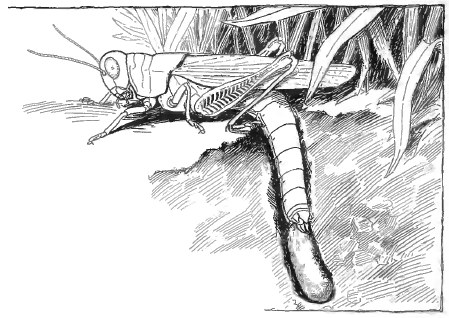The lubbers are out.
(Photograph by Jason van den Bemd)
Lubber grasshoppers, that is.
Robyn, the person who posted this grasshopper on FaceBook, thought this grasshopper looked like a rainbow, and it sure does. Technically it is a plains lubber, Brachystola magma.
(Photograph by Karen Gibson)
This colorful grasshopper is a horse lubber, Taeniopoda eques.
Lubber grasshoppers are active in Arizona in late August and September. Because of their big size, high numbers and bright coloration, people have a lot of questions about them.
1. Are they locusts?
Understandably, there is some confusion about what a locust really is. A locust is a type of grasshopper, but not all grasshoppers are locusts. A locust is a kind of super grasshopper that is highly mobile, and forms large swarms with high numbers of individuals. Often the species that are considered to be locusts undergo physical and behavioral changes when they reach high populations, becoming an enormous eating machine.
Lubbers are basic grasshoppers. They are not locusts, per se.
2. Are they cicadas?
Sometimes people use the term locust for cicadas. Cicadas are in a totally different order of insect. They don’t have jumping legs or chewing mouthparts like grasshoppers do.
This is a cicada. Cicadas have clear wings and sucking mouthparts. They are related to aphids and leafhoppers. They are not grasshoppers.
3. What do lubber grasshoppers eat?
This is a very good question. Despite the name “grass”-hopper, these insects eat a wide variety of plants. They tend to land and nibble a little here, and then hop over and nibble a little there.
The plains lubber above is said to favor wild sunflowers.
The horse lubbers feed on plants that contain toxins. The lubbers take the toxins into their bodies and become toxic themselves. Their black and yellow coloration is a perfect example of classic warning coloration.
As an interesting aside, both of these species are truly omnivores, not herbivores. That means that if lubbers encounter a dead or dying insect, or even other forms of “meat,” they will consume it.
4. Where do they come from?
Female grasshoppers lay their eggs in the soil. many species overwinter in the egg stage and then emerge as nymphs in the spring. Because they are small and often camouflaged, the young nymphs are not as noticeable as the big, flashy adults. (More about grasshopper life cycles)
Grasshoppers are highly mobile and can travel great distances, as well. Pallid-winged grasshoppers from the western coast of California have been found all the way in Hawaii.
5. I have noticed sounds when grasshopper are around. What is that?
Males lubbers and other grasshoppers make noises that sound like buzzes or clicks to attract females. The horse lubbers sit on trees and rub their hind wings on their front wings.
Have you ever seen a lubber grasshopper? Do you have any questions about them?
Are You a Grasshopper? (Backyard Books) by Judy Allen and Tudor Humphries
For a detailed, adult-level book about locusts, try:










